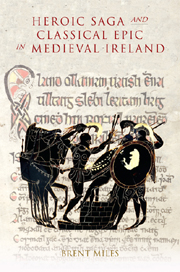Book contents
- Frontmatter
- Contents
- Acknowledgements
- Note on Texts and Editions
- Abbreviations
- Introduction: Figmenta Poetica and Heroic Saga
- 1 Classical Learning in Medieval Ireland: The State of the Question
- 2 The Irish Classical Tales: Texts and Sources
- 3 Classicism and Togail Troí
- 4 Táin Bó Cúailnge and Latin Epic
- 5 The Rhetorical Set Piece and the Breslech of the Plain of Murthemne
- Afterword: An Invitation to Study
- Bibliography
- Index
- STUDIES IN CELTIC HISTORY
5 - The Rhetorical Set Piece and the Breslech of the Plain of Murthemne
Published online by Cambridge University Press: 12 September 2012
- Frontmatter
- Contents
- Acknowledgements
- Note on Texts and Editions
- Abbreviations
- Introduction: Figmenta Poetica and Heroic Saga
- 1 Classical Learning in Medieval Ireland: The State of the Question
- 2 The Irish Classical Tales: Texts and Sources
- 3 Classicism and Togail Troí
- 4 Táin Bó Cúailnge and Latin Epic
- 5 The Rhetorical Set Piece and the Breslech of the Plain of Murthemne
- Afterword: An Invitation to Study
- Bibliography
- Index
- STUDIES IN CELTIC HISTORY
Summary
Classical epic, indebted so much to Homer's Iliad, has a superabundance of detailed, extravagant depictions of life and its loss on the battlefield. Early prose literature in Old Irish, interestingly, has comparatively few. The desultory description of the human battle which comes near the end of Táin Bó Cúailnge is one instance of early Irish indifference to the genre. Heroic single combat, however, fascinated the author; perhaps the impersonal quality of actual battle between armies failed to inspire him. A vigorous tradition of describing battle between armies did develop in the Middle Irish period. The descriptions of battle in these later texts, however, are highly formulaic, and Uáitéar Mac Gearailt proposed that the Iliadic books of Virgil's Aeneid could have been the ultimate literary model. The contrast with the earlier tradition highlights how, as universal as battlefield killing is, literary descriptions of the activity are not universally alike. This chapter is devoted to one episode from the Táin in which the iconography of battle and the effect of battle on a hero are most vividly portrayed, In Carpat Serda 7 in Breslech Mór Maige Murthemne. In terms of chronology this text comes between the contrasting Old Irish and later Middle Irish traditions of portraying battle. Of all the episodes from the Táin here discussed, it is most verifiably contemporary with the ‘school of classical translations’ and the flowering of medieval Irish classical studies in the vernacular.
- Type
- Chapter
- Information
- Heroic Saga and Classical Epic in Medieval Ireland , pp. 194 - 244Publisher: Boydell & BrewerPrint publication year: 2011



